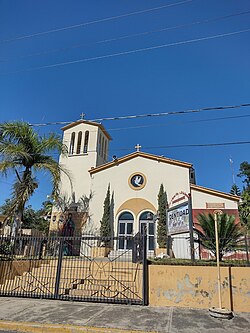Jánico
Jánico | |
|---|---|
 Town church of Jánico. | |
| Coordinates: 19°24′0″N 70°48′0″W / 19.40000°N 70.80000°W | |
| Country | |
| Province | Santiago |
| Settled | 16 March 1494 |
| Incorporated | 29 March 1881 |
| Government | |
| • Mayor | Hilario Fernández (Dominican Liberation’s Party) |
| Area | |
| • Total | 235.03 km2 (90.75 sq mi) |
| Elevation | 370 m (1,210 ft) |
| Population | |
| • Total | 16,993 |
| • Density | 72/km2 (190/sq mi) |
| • Urban | 1,730 |
| • Rural | 15,263 |
| Municipal Districts | 2 |
Jánico (Spanish pronunciation: [ˈxaniko]) is a municipality (municipio) of the Santiago province in the Dominican Republic. Within the municipality there are two municipal districts (distritos municipal): El Caimito and Juncalito.[5]
History[edit]
Christopher Columbus established a stockade here in March 1494, to protect his gold mining ambitions. The prospectivity of gold was established earlier in the year by Alonso de Ojeda's expedition.[6]
Jánico acquired the status of municipality of the province of Santiago in 1881.
The first in the province of Santiago dates back to the 15th century, at the time of discovery, when the Spanish built the ephemeral Santo Tomás de Jánico Fortress, the first built inland on the island, and the second in all of America after Christmas. The remains of this fort are not found in Janicus, which takes its name from the Janicus River.

Jánico is part of a region known as the Sierra (Spanish: La Sierra; pronounced [la ˈsjera]). This region was peopled in the 18th century mostly by ethnic Canarians and French who established a markedly endogamous society in order to preserve their whiteness; only a very few were slaveholders. The Sierra received a sizeable amount of white and mulatto refugees from both Saint-Domingue and the Cibao Valley, the former during the Haitian slave revolts in 1805.[7][8]
Demographics[edit]
In the 1950 census it was the town with the second highest percentage of white people in the country, with 81.1 percent.
According to a 2016 genealogical DNA testing by the Genographic Project, the town has among the highest percentages of both European and pre-Columbian heritages in the island, at 61.5% and 7.8%, respectively, while the African input (including non-black North Africans) was numbered at 29.6%, the second lowest.[9]
Economy[edit]
The main source of the municipality's economy is agriculture, with coffee cultivation as a reference, which makes it one of the most important coffee-growing areas in the country. Remittances also constitute an important element in the economy of this municipality.
Its location in the Central Mountain Range gives it landscape attributes with great potential for mountain tourism. Among its attractions are the Bao reservoir and a botanical garden with an area of 700 hectares of land. On its border with the municipality of Sabana Iglesia is the Taveras hydroelectric complex, located on the Yaque del Norte and Bao rivers. It is formed by the Taveras, Bao dams and the López Angostura reservoir. This endowment contributes 185 GWH to the national electrical system and is used to irrigate approximately 9,100 hectares of land.
For comparison with other municipalities and municipal districts see the list of municipalities and municipal districts of the Dominican Republic.
References[edit]
- ^ Pérez, Narciso (16 August 2016). "PLD dominará seis de los 10 municipios que tiene Santiago" (in Spanish). Santiago: Diario Libre. Retrieved 28 August 2016.
- ^ Superficies a nivel de municipios, Oficina Nacional de Estadistica Archived April 17, 2009, at the Wayback Machine
- ^ "Santo Tomás de Jánico". Google Maps. Retrieved 18 May 2015.
- ^ "Resumen resultados generales Censo 2010" (PDF) (in Spanish). Oficina Nacional de Estadística. 2012. Archived from the original (PDF) on 4 October 2012. Retrieved 26 August 2016.
- ^ Oficina Nacional de Estadistica, Departamento de Cartografia, Division de Limites y Linderos. "Listado de Codigos de Provincias, Municipio y Distritos Municipales, Actualizada a Junio 20 del 2006" (in Spanish). Archived from the original on August 3, 2007. Retrieved 2007-01-24.
{{cite web}}: CS1 maint: multiple names: authors list (link) - ^ Floyd, Troy (1973). The Columbus Dynasty in the Caribbean, 1492-1526. Albuquerque: University of New Mexico Press. pp. 23–24.
- ^ Espinal Hernández, Edwin R. (28 August 2010). "Población, endogamia y consanguinidad. Genealogía en la Sierra de San José de Las Matas" (in Spanish). Instituto Dominicano de Genealogía. Retrieved 16 May 2015.
- ^ Hernández González, Manuel V. (2007). Expansión fundacional y crecimiento en el norte dominicano (1680-1795): El Cibao y la Bahía de Samaná (in Spanish). Santo Domingo: Archivo General de la Nación; Academia Dominicana de la Historia. ISBN 978-9945-020-12-0.
- ^ "Dominicano promedio tiene 49% ADN africano, 39% europeo, y 4% precolombino" [Average Dominican's DNA is 49% African, 39% European, and 4% pre-Columbian]. Acento.com.do (in Spanish). 5 July 2016. Retrieved 26 August 2016.




